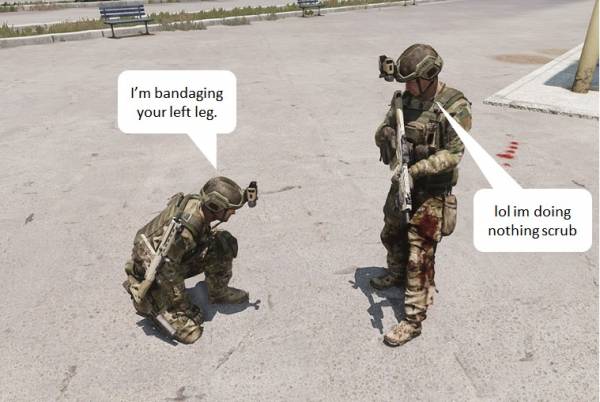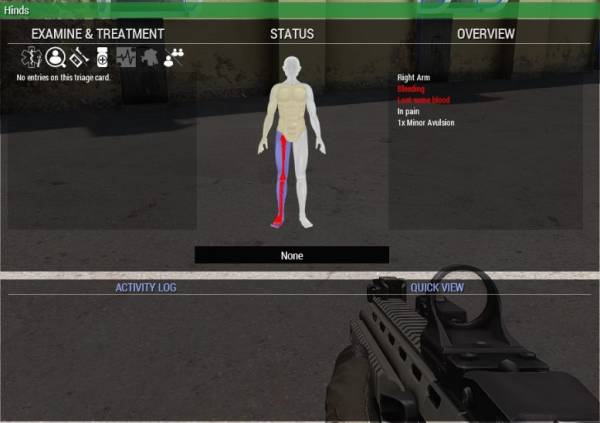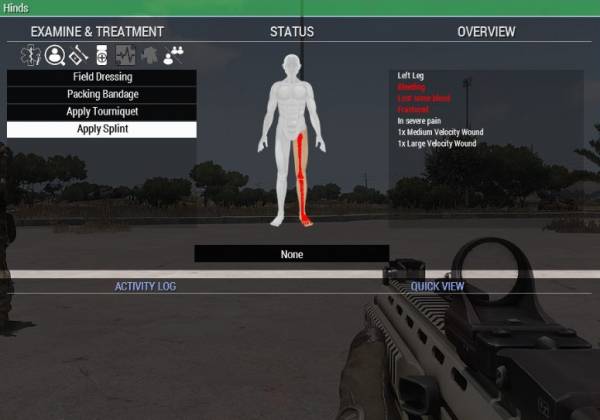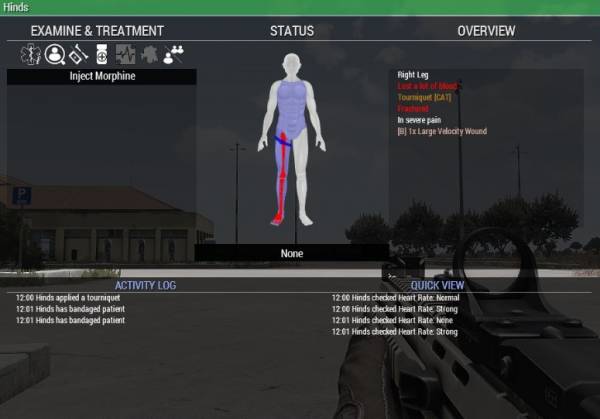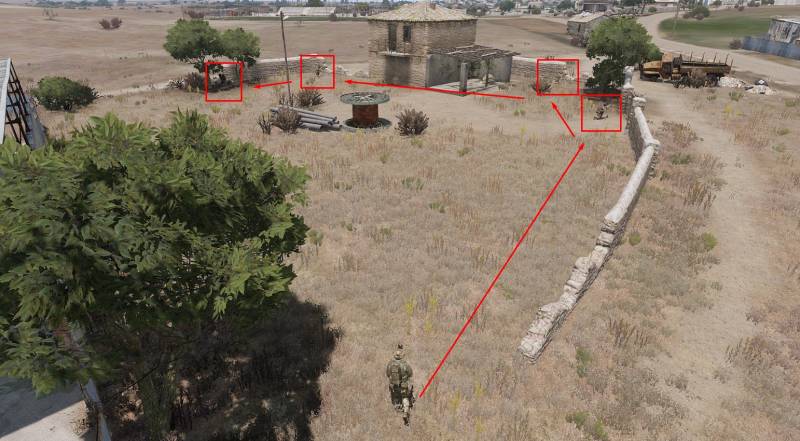Table of Contents
Self and Buddy Aid - Introduction
This page contains procedural recommendations for treating yourself or another as a non-medic.
Before continuing, it is suggested to take a look at the Medical Equipment page. Of interest to a non-medic are the Field Dressing and QuikClot bandages, Morphine Autoinjector, Splint, and Tourniquet. To avoid duplicate information, equipment will not be discussed at length on this page.
Finally, the ACE Medical Menu is assumed to be the “standard” way of performing medical treatment. The Medical Menu is generally faster, less prone to making mistakes, and less cumbersome than the ACE Interaction system. If you are not familiar with this menu, you may navigate down to Appendix A for a video overview. If you are an ACE Interaction loyalist, that's fine, and most everything you read will still apply. You'll just need to explore the interaction tree to find the specific spot to use some of the items.
Overview
- Assess Injuries
- Stop Bleeding
- Treat Pain
- Hold Security
There are also some general best practices listed below, outside of the actual process of treating your (or your buddy's) injuries.
General Recommendations
Move to cover or, if none is available, concealment. Worst-case, lay down to make yourself small. Try not to treat yourself or another in the open as you are vulnerable to incoming fire. If a casualty is in the open, do your best to drag them in to cover or concealment. Only use carrying as a last resort, as the animation to pick up a casualty is slow and leaves you vulnerable to incoming fire. Only carry when you have one or two other individuals nearby who can provide security for you.
Communicate with your team leader and other individuals around you. If you or your buddy are significantly wounded, make sure you can get help treating the casualty or providing security. If your team leader can quickly summon the squad's medic, it may help save a casualty that would have otherwise died.
From Lonely Island's YOLO. “Just take our advice and hide.”
Maintain security. If you and your buddy are wounded, the lesser-wounded of the two should hold security to ensure the buddy team's protective posture is never compromised. Alternate treating yourselves to avoid a situation where you are both bandaging and get walked up on (and possibly killed) by enemy personnel.
If you are bandaging a casualty at the same time as someone else, call out what action you're performing on what region. For example, “bandaging head,” “tourniqueting right arm,” and so on. This avoids wasted time and resources addressing the same wound(s).
Step 1: Assess Injuries
Note that the arm (less-saturated yellow) is slightly less-wounded than the chest (more-saturated yellow). The leg has already been bandaged.
You need to know what you're dealing with before you start working. You can use the paper doll as a rough guide. Wounded regions on the body are colored on a gradient between very pale yellow (lightly wounded) and a higher-saturation orange (heavily wounded).
Prioritize zones on the body that are closer to orange. Quickly formulate a plan to address all of the wounds.
Take note of fractures. These are indicated by red bone structure visible on the limb. Similar to wounds on these limbs in general, fractured legs force you to limp and fractured arms induce aim sway. Fractures should typically be addressed after bleeding has been taken care of.
If you're treating someone else and they're unconscious, check their pulse on any region of their body that does not have a tourniquet. If it comes back “none,” and they aren't ragdolled, then they're in cardiac arrest. Refer to Appendix B for what to do in that circumstance. Remember, though: you still need to address their wounds even if they're in cardiac arrest.
Finally, remember that wounds (and fractures) on limbs have additional effects. Wounded arms are difficult to aim with, and wounded legs cause you to limp. There may be circumstances where you choose to e.g. bandage your legs while laying in the open so that you can then sprint in to cover rather than trying to crawl or limp in to cover. Knowing when and where to do these sorts of “optimizations” comes with experience.
Note: If you are colorblind, you may want to quickly click through the various zones to confirm the wounds on them, or change your game/monitor's color settings in such a way that you are able to distinguish between unwounded, lightly wounded, and heavily wounded limbs on the paper doll.
Step 2: Stop Bleeding & Fix Fractures
We have a pretty nasty set of leg wounds and a fracture. Once we bandage (or tourniquet) the wounds, we can splint the fracture.
Now that you know the wounds you are dealing with, you can address them. Limbs can be immediately addressed by using a tourniquet on them. Torso or head will need to be bandaged. Make smart use of the resources at your disposal: if you only have one tourniquet, use it on the most-wounded limb to address all of that bleeding at once. Remember: if you're treating someone else, you use their supplies first (default setting), so you potentially have access to an extra tourniquet and so on.
Field Dressings will generally close a wound in fewer applications than Quikclot, but they fall off much faster. It may be preferable to use Field Dressings to rapidly close a major wound (thus avoiding significant blood loss) while reserving the Quikclot for use on minor injuries to keep those sealed for longer. Keep this in mind when deciding what to apply and where. Sometimes, though, you'll only have one or the other, and you'll have to make do with what you have remaining. The most important thing is to apply bandages quickly rather than trying to calculate the most optimal distribution of bandages to wounds.
Once you take care of bleeding, you can address fractures. Fractures are treated with splints in the same tab that you apply bandages or tourniquets.
Finally, remember to remove the tourniquet once the wounds have been bandaged. Leaving a tourniquet on too long causes pain to accumulate that can ultimately knock the casualty out, so don't forget to take it off. However, it could be left on a casualty (especially an unconscious one) to conserve bandages if necessary.
Step 3: Treat Pain
Since we've lost a large amount of blood (more than “lost a lot of blood”), we might choose to forego treating pain.
Pain doesn't generally kill, but bleeding does. Now that bleeding has been addressed, you can make the decision whether or not to treat the pain. Pain induces aim sway that can make fighting difficult, so it's generally desirable to treat it when possible. However, the deciding factor is heart rate. If your heart rate is too low, you risk falling unconscious by dosing yourself with morphine, because it lowers your heart rate as a side effect.
In general, it is safe to administer morphine when you haven't “lost a lot of blood.” Your heart rate will be nominal or elevated and the morphine is unlikely to put your heart rate under the conscious threshold. If you hear your heart beat (audibly, it's a sound effect) at all, do not administer morphine. If you begin to hear your heart beat after administering morphine, inform your team leader and/or a medic immediately.
Step 4: Hold Security
Once you're done treating yourself or the casualty, you should immediately return to a protective posture. Even if there are others in need of treatment, remember that someone needs to be on security. Unless another casualty is going to die because you don't help them, you should be on security since you've already spent some time treating yourself or another.
All the usual things apply: prioritize cover over concealment, watch your spacing within your team, and maintain all-around three-dimensional defense. If you have a critical weapon system (the automatic rifle, the anti-tank launcher, a marksman rifle, etc) try to deploy that in a location that addresses the enemy's most likely or most dangerous course of action. If you need help deciding where to go, ask your team leader. However, it could be your team leader who is unconscious, so being able to make these determinations on your own (or with the aid of those around you) is a definite advantage.
This incredibly advanced medic, upon arrival to the team, immediately goes around the security perimeter to treat any wounded rather than making you go to them.
The next time you're near a medic (or if a medic is summoned to your team), you should get the medic to stitch your wounds to prevent them from reopening and using up more bandages. You may not always have immediate access to a medic, so be patient. Furthermore, when the medic is around, do not leave security to go sit on top of the medic. Inevitably you will see a lot of people doing this. That does not mean that you yourself should do this. Either the medic will go around to everyone on security (without being asked) and address any issues or you can ask your team leader to specifically send the medic your way (or do this yourself if your team leader is incapacitated or otherwise unavailable).
And that's all there is to it! Feel free to ask questions or discuss on the Discord in #arma3.
Appendix A: ACE Medical Menu Video
Appendix B: Cardiac Arrest
If you're treating yourself, congratulations, you're not in cardiac arrest! Others might not be so lucky, though.
Short version, cardiac arrest is a “second chance” timer for individuals who would otherwise have died. It does not protect against fatal damage and you can still die without being put in to cardiac arrest (most commonly from traumatic injury due to large explosions, eating autocannon rounds to the chest, or being shot in the head). Factors such as blood pressure or heart rate being too low can put someone in to cardiac arrest. Most commonly blood loss is the root cause during gameplay, although player error or mischief such as overdosing someone on epinephrine or morphine can also cause cardiac arrest.
To know if someone is in cardiac arrest, check their pulse on any zone of their body. If the output is “none” and the individual is not ragdolled they are in cardiac arrest. A medic should be summoned immediately. The best things you can do in this scenario are 1) hold security and 2) perform CPR. If there are others nearby get them to hold security while you perform CPR on the casualty. This is more likely to succeed as theoretically anyone should be capable of holding security, but not necessarily everyone will know how to perform CPR.
CPR is available in the Advanced Treatments tab of the Medical Menu on the chest region only, and only when it is relevant. You will not be able to perform CPR on conscious individuals, only on unconscious individuals (which includes “regular” unconsciousness, cardiac arrest, and being dead).
Remember, too, that you still need to address a casualty's wounds, even if they're in cardiac arrest. Continued blood loss will waste resources (primarily fluids, which are usually in limited supply) and make it more difficult for the medic to treat the casualty. Best-case scenario, someone is doing CPR, someone is addressing wounds, and everyone else is on security. If you're the only person available to treat the casualty, alternate between CPR and addressing wounds. This way, the casualty is more likely to survive until the medic arrives but you're also helping to conserve time and resources by stopping blood loss.
Once a medic arrives, they will likely need a helper to continue CPR while everyone else holds security. Avoid bunching up around the casualty: instead, punch out your security to expand the bubble around the medic while they work. Ideally your team leader will coordinate this but it may be the team leader who is unconscious, so anyone can help organize security in a pinch.
If you are alone, unfortunately, it is a risk to perform CPR (or treat the casualty at all). You must weigh this risk when choosing to perform CPR without others to provide security for you. Another factor is the use of resources to save the casualty. If resources are tight, it may be decided to abandon the individual to their fate in favor of using limited resources (especially fluids) to keep multiple other wounded individuals alive, although this is generally beyond your purview as a rifleman.



